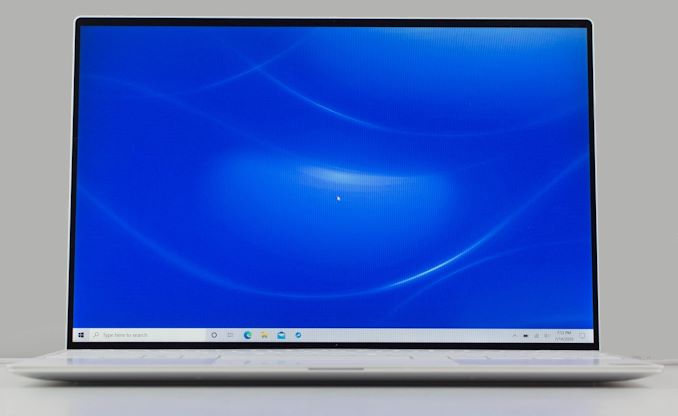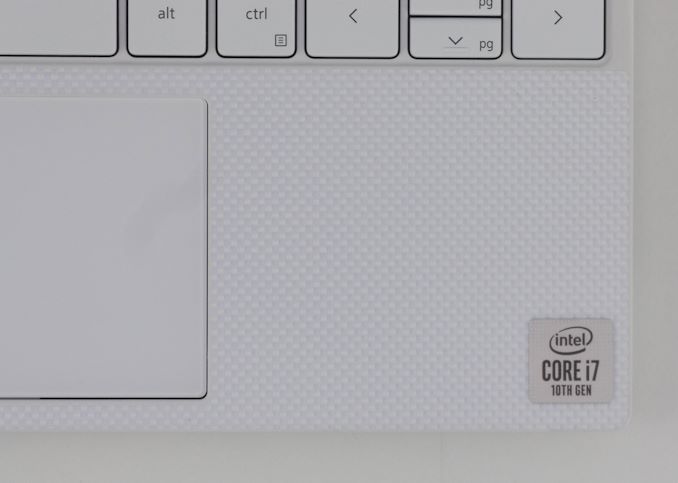The Dell XPS 13 (9300) Review: Return of the King
by Brett Howse on July 16, 2020 10:00 AM EST
Dell changed the Windows laptop market in a single stroke with the launch of the updated XPS 13 back in 2015, ushering in the world of the InfinityEdge display, and moving the entire industry forward. We were fortunate enough to get a chance to check out the precursor to the new XPS 13 back in November, with a review of the XPS 13 2-in-1. Dell had chosen not to rest on their laurels, and the 2-in-1 proved to be one of the best notebooks around if you needed a compact and powerful convertible laptop. Today we are evaluating the traditional clamshell version of the XPS 13, and while it offers many of the same features and design touches, it does so in a more familiar form factor that many customers are going to prefer.
For the 2020 refresh, Dell has made the refreshing move to taller displays, as we saw with the XPS 13 2-in-1. As a result the XPS 13 uses 13.4-inch display panel with a 16:10 aspect ratio, offering more vertical space for getting work done, and some convenient padding to place controls when watching 16:9 content. The larger display fits into a chassis that is actually 2% smaller than the outgoing design, with the new XPS 13 offering a 91.5% screen to body ratio.
This is actually the second time that Dell has refreshed the XPS 13 within the last year. The company previously updated the XPS 13 in August 2019 to use Intel's 10th generation Core processors, but presumably due to limited supply of Intel’s then-new Ice Lake platform, Dell opted to launch that iteration with Comet Lake-U processors. And under more normal circumstances we would have expected Dell to stick with an annual cadence – and thus Comet Lake – for an entire year. Instead, to some surprise, Dell gave the XPS 13 a further mid-generation refresh, launching the Ice Lake-based XPS 13 9300 model that we are reviewing today, and bringing the clamshell XPS 13 to parity with the 2-in-1 version.
The switch from Comet Lake to Ice Lake, in turn, is a significant one. it means the XPS 13 gets Intel’s new Sunny Cove CPU architecture, as well as the much-improved Gen 11 graphics. Dell offers Core i3, i5, and i7 models, with the Core i3 and i5 offering G1 graphics, meaning 32 Execution Units (EUs), and the top-tier Core i7-1065G7 featuring the full 64 EUs on the GPU side. Just as a comparison, the Comet Lake-U only offered 24 EUs of Gen 9.5 graphics, so even the base Ice Lake models still offer a 33% larger (and much newer) GPU than the outgoing models.
The move to Ice Lake also brings some badly-needed LPDDR4X support, which in turn means a 32 GB maximum memory option in the XPS 13 9300, up from 16 GB previously. Although Dell still lists a paltry 4 GB option on their specifications sheet, a quick look at the Dell.com site shows that, at least in the USA, it appears that 8 GB is the new minimum, and that is a welcome change. Offering just 4 GB of RAM in a premium Ultrabook was always a poor choice, even if it did allow Dell to hit a slightly lower price bracket. On the storage front there is more good news, with 256 GB the new minimum, with up to 2 TB available, and all drives are PCIe x4 NVMe offerings.
| Specifications of the Dell XPS 13 9300-Series | |||
| General Specifications As Tested: Core i7-1065G7 / 16GB / 512GB / 1920x1200 |
|||
| LCD | Diagonal | 13.4-inch | |
| Resolution | 1920×1200 | 3840×2400 | |
| Brightness | 500 cd/m² | 500 cd/m² | |
| Contrast Ratio | 1800:1 | 1500:1 | |
| Color Gamut | 100% sRGB | 100% sRGB 90% P3 |
|
| Features | Dolby Vision | Dolby Vision | |
| Touch Support | with or without touch | Yes | |
| Protective Glass | Corning Gorilla Glass 6 in case of touch-enabled model | ||
| CPU | Intel Core i3 1005G1 (4MB cache, up to 3.4GHz) Intel Quad Core i5 1035G1 (6MB cache, up to 3.6GHz) Intel Quad Core i7 1065G7 (8MB cache, up to 3.9GHz) |
||
| Graphics | Intel UHD Graphics Intel Iris Plus Graphics |
||
| RAM | 4 - 32 GB LPDDR4X-3733 DRAM (soldered/onboard) | ||
| Storage | 256 GB PCIe 3.0 x4 SSD 512 GB PCIe 3.0 x4 SSD 1 TB PCIe 3.0 x4 SSD 2 TB PCIe 3.0 x4 SSD |
||
| Wireless | Killer AX1650 Wi-Fi 6 + Bluetooth 5.0 (based on Intel's silicon) Killer AX500 Wi-Fi 6 + Bluetooth 5.0 (based on Qualcomm's silicon) |
||
| USB | 3.1 | 2 × TB 3/USB Gen 3.1 Gen 2 Type-C | |
| 3.0 | - | ||
| Thunderbolt | 2 × TB 3 (for data, charging, DP displays) | ||
| Cameras | Front | 720p HD webcam | |
| Other I/O | Microphone, 2 stereo speakers, audio jack | ||
| Battery | 52 Wh | 45 W AC Adapter (USB Type-C) | ||
| Dimensions | Width | 295.7 mm | 11.64 inches | |
| Depth | 198.7 mm | 7.82 inches | ||
| Thickness | 14.8 mm | 0.58 inches | ||
| Weight | non-touch 1.2 kilograms | 2.64 pounds touch-enabled 1.27 kilograms | 2.8 pounds |
||
| Launch Price | Starting at $999.99 | ||
Dell has gone all-in on USB-C with the new XPS 13, with one port on each side of the notebook. Both feature Thunderbolt 3 with 4 lanes, as well as power delivery for charging. The lack of a Type-A port may inconvenience some, but Dell does include an adapter in the box to assist. Wireless is the Killer AX1650, which based on the latest Intel AX200 wireless adapter – and with Intel purchasing Killer this partnership seems like it is not going anywhere.
If you read our review of the 2-in-1 version of this laptop, you will undoubtedly notice a lot of similarities. As they are from the same product line, that is not an accident: Dell has now refreshed their entire XPS series of laptops with a similar design philosophy. Let’s take a peek at what is new.











224 Comments
View All Comments
sorten - Thursday, July 16, 2020 - link
eek: Here's a review comparing a $600 Acer laptop with the 4700u (not AMD's top mobile CPU) against an XPS 13 with the Intel 1065G7, and it's not pretty. Tiger Lake is supposed to have a massively improved GPU (Intel's new Xe brand), but we don't know much about the CPU side yet.https://www.anandtech.com/show/15762/the-acer-swif...
Deicidium369 - Thursday, July 16, 2020 - link
The CPU side of Tiger Lake - 4 cores is 17% slower than AMD Renoir 8 cores. Xe LP (the 96 EU iGPU in Tiger Lake) is equal to the MX350 from Nvidia.Santoval - Friday, July 17, 2020 - link
According to unverified leaks. I await for actual performance values, while being skeptical that Intel managed to raise the IPC (and/or clocks) of Tiger Lake so much over Ice Lake (I obviously refer to the CPU block, not the iGPU block; I have no doubt that Xe will outperform AMD's Vega iGPUs - that is AMD's choice for having a 3-year old GPU design compete against Intel's latest and greatest Xe GPU, in an act of apparent self-sabotage).gescom - Friday, July 17, 2020 - link
Lenovo ThinkPad T14s: AMD Ryzen 7 Pro 4750U leaves Intel in the dust.Notebookcheck.net
Jorgp2 - Thursday, July 16, 2020 - link
Again why are shilling?Who thinks a craptop vs an Ultrabook is a valid comparison.
Lord of the Bored - Friday, July 17, 2020 - link
I think the point is that the AMD processor being used in the craptop is kinda wrecking Intel's "solid" and "competitive" offerings.PeterCollier - Friday, July 17, 2020 - link
So AMD catches up with Intel after Intel falls behind by 4 years with their 10nm process. Big __ deal.Korguz - Friday, July 17, 2020 - link
the bigger deal, intel STILL hasn't regained its lead during the same timeframe.Spunjji - Friday, July 17, 2020 - link
@Jorgp2 It's kind of funny that your argument is "It's okay for Ultrabooks to be slower than craptops". The comparison is not only valid, it's *damning*. There shouldn't be any reason why you can get that performance from a junk notebook but not in the #1 Ultrabook design.Jorgp2 - Friday, July 17, 2020 - link
Because you're comparing a $300 craptop to an Ultrabook.Of course the craptop is going to be cheaper.